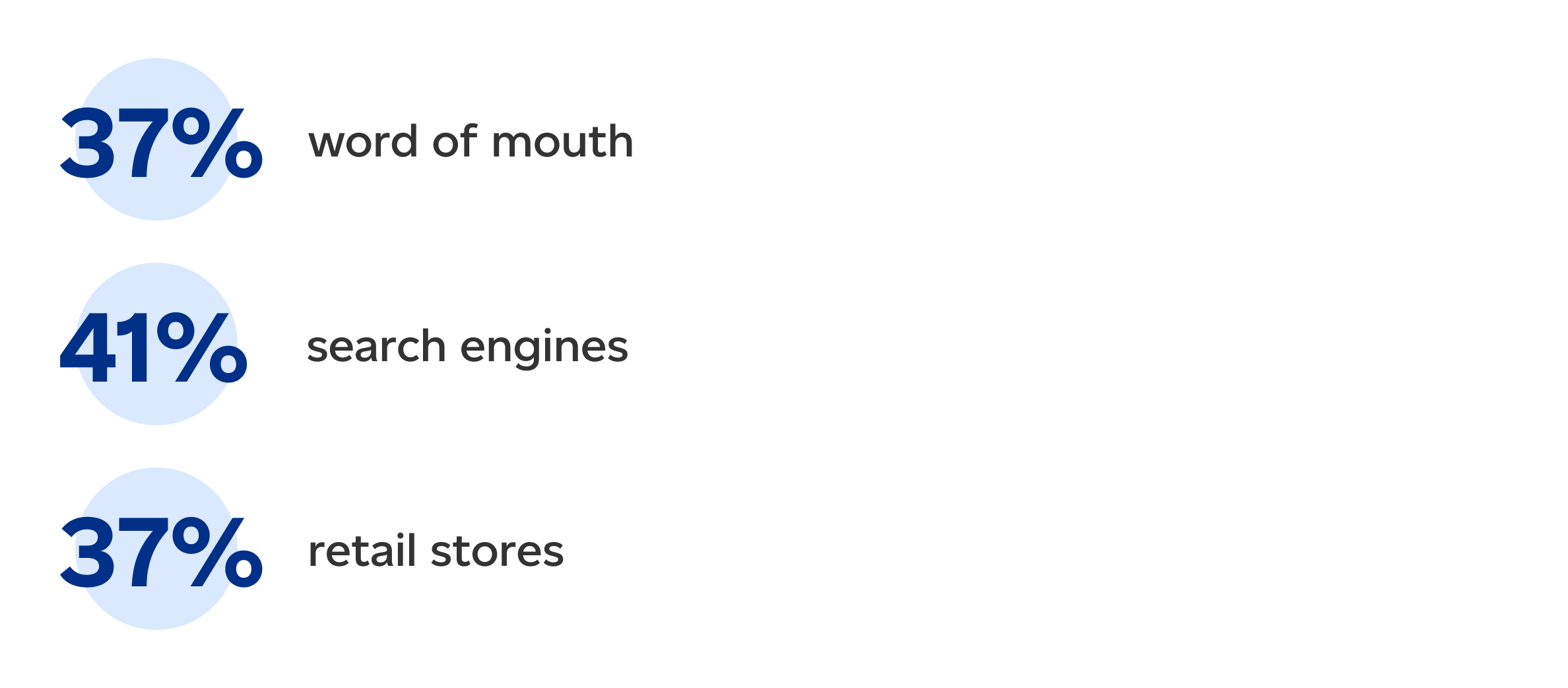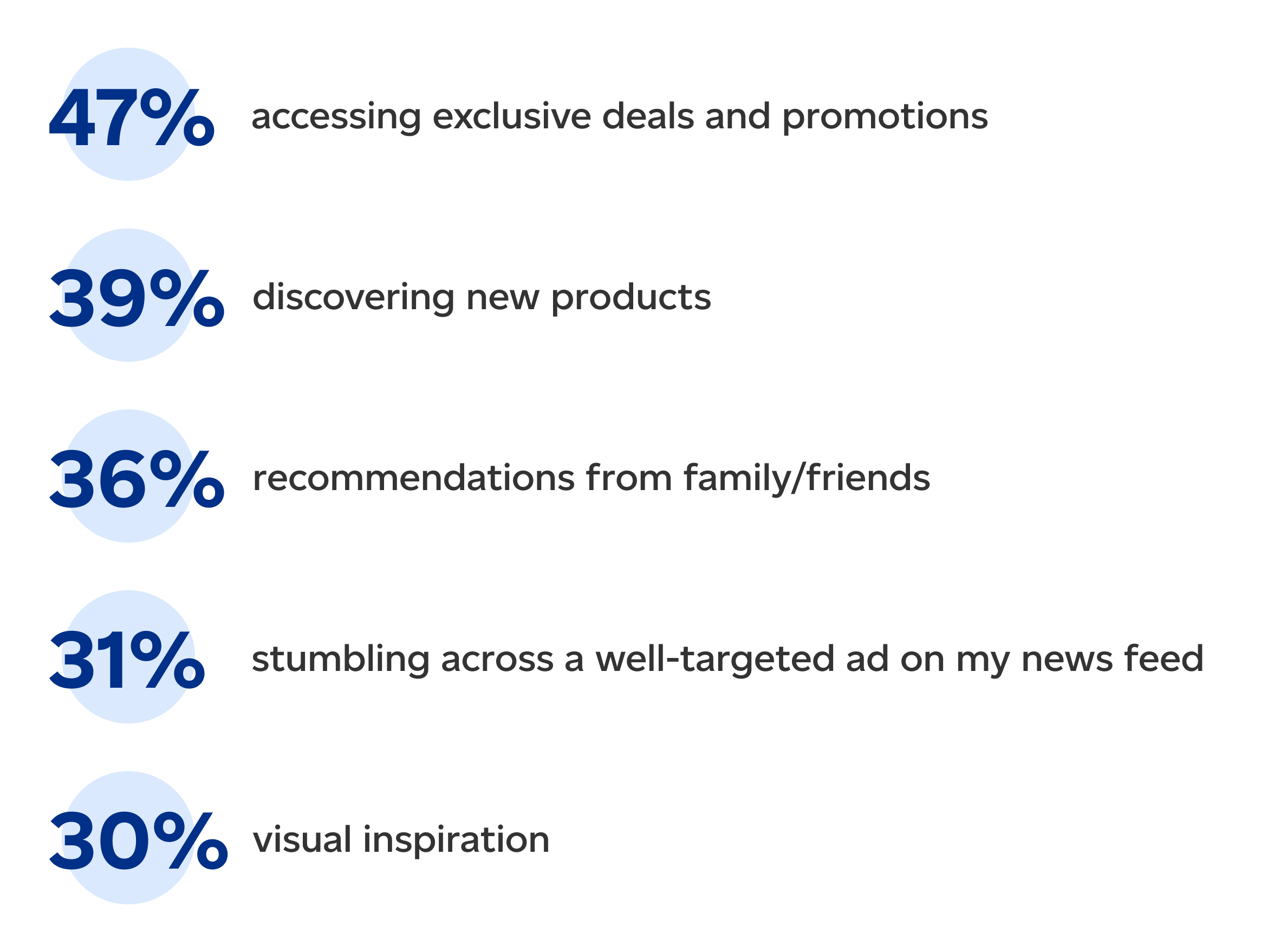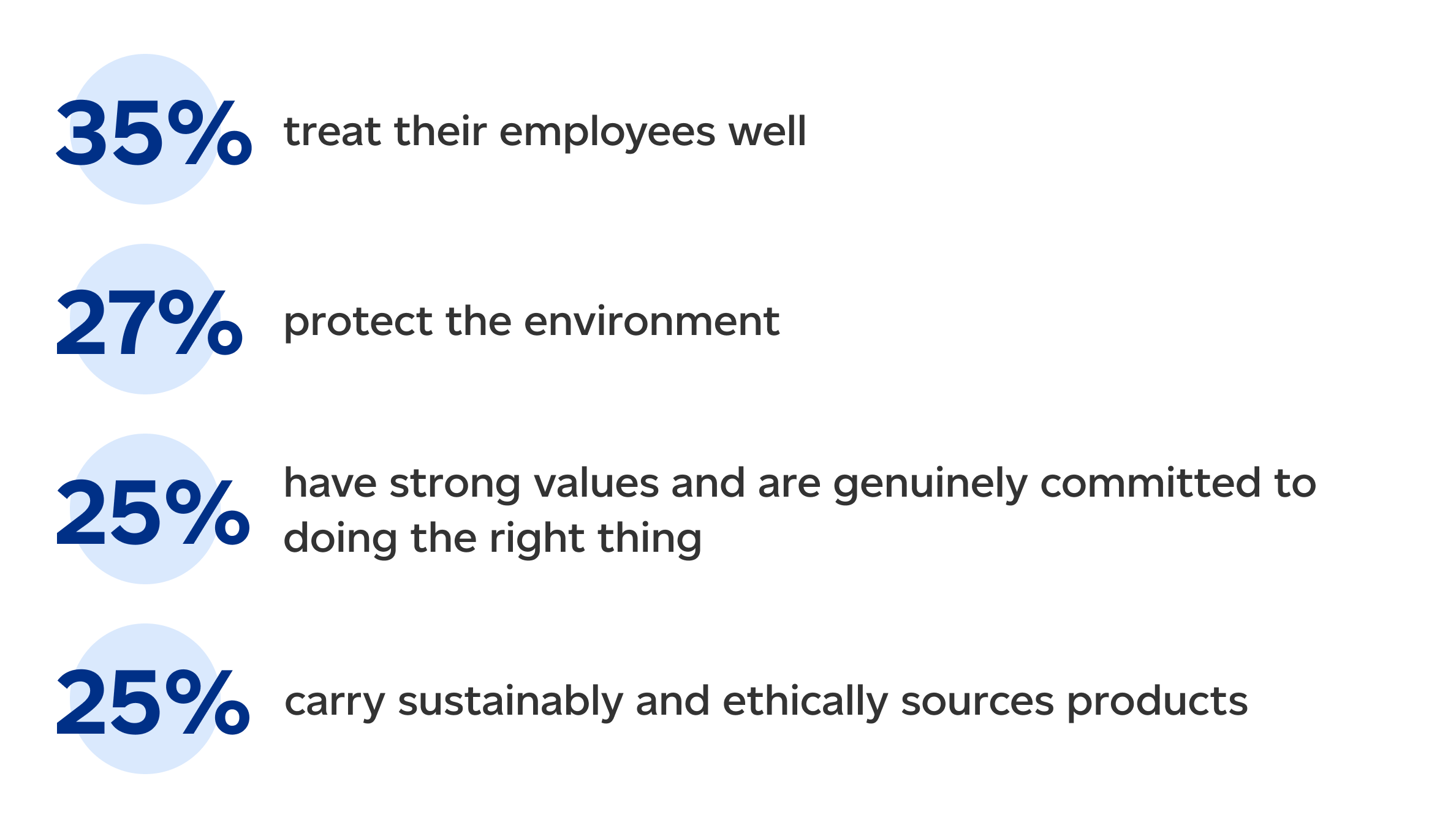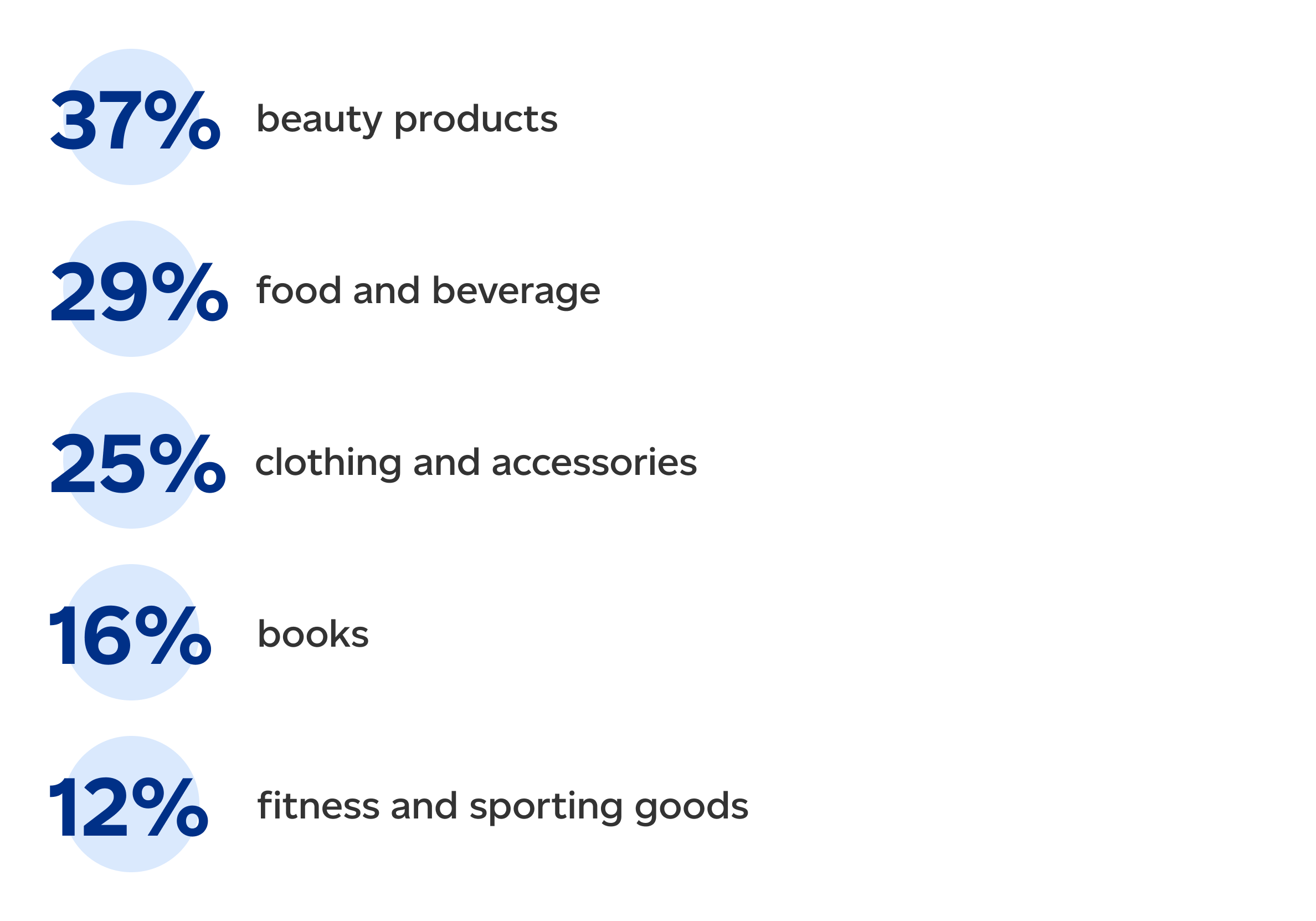Here are 10 notable ecommerce trends for 2024 along with some tips to inspire your thinking, fuel your planning and keep your business one step ahead of the consumer – and your competition.
Table of Contents
1. Omnichannel
2. Social commerce
3. Artificial Intelligence
4. Immersive experiences
5. Sustainable options
6. Ethics and values
7. Search and community
8. Coping with cost of living
9. Subscription lifestyles
10. Fraud protection and prevention
1. Omnichannel
Omnichannel presence is a necessary part of a retailer’s customer acquisition and retention efforts. If you want to bring customers in and encourage them to stay, businesses need to embrace multiple channels to reach customers. Canadian shoppers are discovering new brands in online and offline channels, with most noting that they discover brands via:1
Including an omnichannel strategy enables your business to tailor its approach, delivering shoppers a seamless and personalized shopping experience. As market demands and customer behaviour continue to evolve, brands will need to commit to omnichannel experiences like virtual shopping, livestream shopping and offering seamless and personalized experiences across channels.
Tip: Understand where your consumers are discovering new brands and purchasing products. Use this information as a guide to develop your omnichannel strategy, considering channels like brick-and-mortar stores, online platforms and virtual shopping experiences.
2. Social commerce
The shift towards social commerce represents a significant change in the way that consumers interact with brands. To be successful, brands will need to be ready to engage and sell in new ways.
Social commerce simplifies the shopping experience for consumers – especially millennials and Gen Z who are the primary audience participating in social commerce. It allows and facilitates transactions in-app, meaning that a shopper never has to visit an ecommerce website to place an order.
The top motivators that drive Canadian shoppers to purchase from a business through social media are:2
Brands are showing up with more organic, less promotional messaging and are leaning on influencer marketing to expand their reach and build trust. Globally, social commerce is expected to generate more than $2 trillion by 2025.3
Tip: To drive your social commerce engine, ensure that your marketing strategy maximises your visibility across channels. Consider developing an influencer strategy, investing in social media advertising or engaging with other individuals and brands across social channels.
3. Artificial Intelligence
Leveraging artificial intelligence (AI) in your day-to-day ecommerce operation is becoming increasingly important to create efficiencies and meet your customers’ evolving needs. This includes chat bots to provide instant customer support, AI-generated product recommendations and consumer data to understand and anticipate consumer preferences. Incorporating AI is a great way to provide a personalized, best-in-class shopping experience that will keep your customers coming back for more.
Tip: Customer data is key to creating curated experiences. Start by mining, analyzing and using algorithms to deliver the right curation of products and services and drive profitability.
4. Immersive experiences
Immersive technology offered through augmented reality (AR) and virtual reality (VR) will revolutionize the shopping experience for consumers. The use of immersive technology not only enhances the visual aspect of online shopping but also provides shoppers with a personalized experience and engaging interaction. A shopper can use AR to see how a particular shade of lipstick will look when applied or how a new couch would look in their living room. These features empower shoppers to feel confident in their online purchase, overcoming a common barrier faced by many online shoppers.
Find inspiration in these best-in-class examples of online retailers investing in AR:
Tip: Harness the power of immersive technology by providing shoppers with the opportunity to visualize a product in their environment ahead of purchasing to increase revenue, improve customer service and reduce returns volumes.
Sign up for our ecommerce newsletter for exclusive access to trends, insights and events.
Sign up5. Sustainable options
Environmental sustainability continues to play an important role in purchasing decisions. Consumers are looking for eco-friendly products and packaging and expect ecommerce brands to prioritize sustainability in how they do business. This includes greater focus on sustainable and eco-friendly return processes.4
Tip: Highlight the positive outcomes of your environmentally friendly practices such as waste reduction, decreased emissions and decarbonization, resource efficiency and preservation of biodiversity. Your customers want to hear about how your business is making a difference! Use your website, enewsletter and social channels to highlight your achievements and focuses.
6. Ethics and values
Beyond sustainability, consumers are seeking brands that share their values. Did you know 2 in 5 consumers strongly consider values-driven attributes in their decision making?5 These attributes many encompass a brand’s investment in diversity, social justice and inclusivity, to name a few.
When choosing where to shop online, consumers expect brands to:6
Tip: To gain valuable insights around your environmental, social and governance (ESG) investments it’s important that you keep a pulse on your customers’ values. Consider sending surveys or using data to understand how customers perceive, interact and engage with your brand.
7. Search and community
In 2024, brands will continue to invest in search engine marketing (SEM) and grow their community via social forums and platforms. Shoppers over the age of 55 are much more likely than younger demographics to learn about new brands through search engines (47%), while younger demographics discover through social networks like Instagram (40%), YouTube (38%), Tik Tok (32%) and influencers (28%).7
That means it’s important that brands are present – and engage – across channels where your customers are consuming content.
Brands capable of building community through forums, social media groups and interactive content, will create spaces for customers to connect, share experiences and become brand advocates. This will boost brand visibility and enhance customer trust and engagement.
Tip: As you consider marketing planning, ensure that you’re investing in tactics and platforms that make sense for your business.
8. Coping with cost of living
As the cost of living continues to rise and economic uncertainty remains top of mind for Canadians, it’s important to consider how your brand can continue to cater to the needs of your customer without comprising the affordability or quality of your product. Canadian shoppers indicated that offering free shipping (65%), providing discounts and promotions (58%), improving the quality and durability of products (53%) and enhancing loyalty programs to include better discounts (46%)8 are ways to support your customers during these potentially trying times. Brands that understand the financial challenges and address them will stand out.
Even in uncertain times, innovation will continue to be important. Brands can benefit from traffic-generating promotions and offers uniquely targeted at loyal customers. Customer loyalty is crucial for business growth.
Tip: Your customers will recognize that these times of economic uncertainty can also be hard for businesses. Be transparent in your communications to continue to foster loyalty and connection with your customers.
9. Subscription lifestyles
Consumers appreciate the convenience and predictability of subscriptions – especially when there are perceived cost savings attached to signing up. When done properly, subscription models foster loyalty by offering a curated experience, increase average spend per customer, help predict and manage fulfillment, generate recurring revenue for businesses, and allow brands to capture valuable data that can drive decisions and be used to improve the customer experience. Keep in mind that subscription models aren’t right for every business. Here at the types of subscription boxes Canadian shoppers are subscribed to:9
Tip: Before you offer subscription boxes, evaluate if there is demand for your product to warrant offering it as a subscription. Pet food, health food and beauty product meal kits, arts and crafts, hobbies, alcoholic beverages and health and wellness boxes tend to be the top categories for repeat purchases.10
10. Fraud protection and prevention
Shoppers continue to turn to ecommerce in record numbers, enabling fraudsters to execute fraudulent attacks against brands and consumers alike. As an ecommerce business, it’s important that you protect yourself from hackers – and ensure that you’re investing in ways that let your customers know your business is legitimate.
Nearly two-thirds of Canadians are skeptical of new retailer websites due to possible fraud.11 To build trust, site your ecommerce site needs to look professional and include appropriate contact information. To further enhance credibility, ensure that your brand’s social channels are active and work with partners to prioritize delivery security.
Consider adding security to your site that discourages online bots and monitors orders for any oddities – especially during peak seasons.
Tip: Err on the side of caution when it comes to fraud. When in doubt, conduct a manual review. Don’t be afraid to contact a customer if there are questions related to an order – they will appreciate your caution and attention to detail.
Contact an ecommerce expert
Find out how we can help take your business to the next level. Fill out the form below and one of our ecommerce experts will reach out to you within one business day.
Contact an expert



